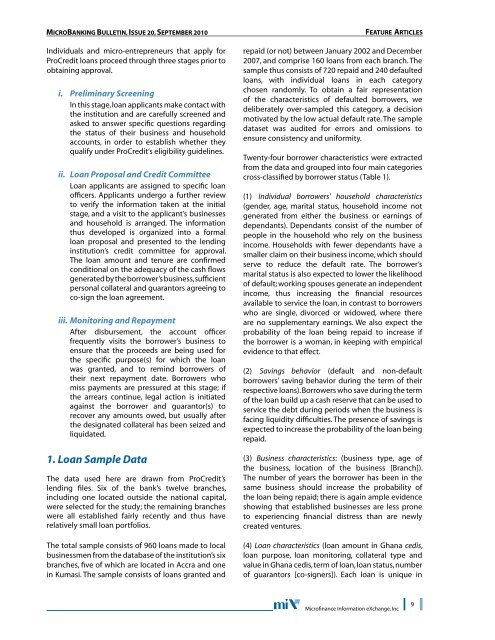THE MICROBANKING BULLETIN No. 20 - Microfinance Information ...
THE MICROBANKING BULLETIN No. 20 - Microfinance Information ...
THE MICROBANKING BULLETIN No. 20 - Microfinance Information ...
You also want an ePaper? Increase the reach of your titles
YUMPU automatically turns print PDFs into web optimized ePapers that Google loves.
<strong>MICROBANKING</strong> <strong>BULLETIN</strong>, Issue <strong>20</strong>, September <strong>20</strong>10Individuals and micro-entrepreneurs that apply forProCredit loans proceed through three stages prior toobtaining approval.i. Preliminary ScreeningIn this stage, loan applicants make contact withthe institution and are carefully screened andasked to answer specific questions regardingthe status of their business and householdaccounts, in order to establish whether theyqualify under ProCredit‘s eligibility guidelines.ii. Loan Proposal and Credit CommitteeLoan applicants are assigned to specific loanofficers. Applicants undergo a further reviewto verify the information taken at the initialstage, and a visit to the applicant’s businessesand household is arranged. The informationthus developed is organized into a formalloan proposal and presented to the lendinginstitution’s credit committee for approval.The loan amount and tenure are confirmedconditional on the adequacy of the cash flowsgenerated by the borrower’s business, sufficientpersonal collateral and guarantors agreeing toco-sign the loan agreement.iii. Monitoring and RepaymentAfter disbursement, the account officerfrequently visits the borrower’s business toensure that the proceeds are being used forthe specific purpose(s) for which the loanwas granted, and to remind borrowers oftheir next repayment date. Borrowers whomiss payments are pressured at this stage; ifthe arrears continue, legal action is initiatedagainst the borrower and guarantor(s) torecover any amounts owed, but usually afterthe designated collateral has been seized andliquidated.1. Loan Sample DataThe data used here are drawn from ProCredit’slending files. Six of the bank’s twelve branches,including one located outside the national capital,were selected for the study; the remaining brancheswere all established fairly recently and thus haverelatively small loan portfolios.The total sample consists of 960 loans made to localbusinessmen from the database of the institution’s sixbranches, five of which are located in Accra and onein Kumasi. The sample consists of loans granted andFEATURE ARTICLESrepaid (or not) between January <strong>20</strong>02 and December<strong>20</strong>07, and comprise 160 loans from each branch. Thesample thus consists of 7<strong>20</strong> repaid and 240 defaultedloans, with individual loans in each categorychosen randomly. To obtain a fair representationof the characteristics of defaulted borrowers, wedeliberately over-sampled this category, a decisionmotivated by the low actual default rate. The sampledataset was audited for errors and omissions toensure consistency and uniformity.Twenty-four borrower characteristics were extractedfrom the data and grouped into four main categoriescross-classified by borrower status (Table 1).(1) Individual borrowers’ household characteristics(gender, age, marital status, household income notgenerated from either the business or earnings ofdependants). Dependants consist of the number ofpeople in the household who rely on the businessincome. Households with fewer dependants have asmaller claim on their business income, which shouldserve to reduce the default rate. The borrower’smarital status is also expected to lower the likelihoodof default; working spouses generate an independentincome, thus increasing the financial resourcesavailable to service the loan, in contrast to borrowerswho are single, divorced or widowed, where thereare no supplementary earnings. We also expect theprobability of the loan being repaid to increase ifthe borrower is a woman, in keeping with empiricalevidence to that effect.(2) Savings behavior (default and non-defaultborrowers’ saving behavior during the term of theirrespective loans). Borrowers who save during the termof the loan build up a cash reserve that can be used toservice the debt during periods when the business isfacing liquidity difficulties. The presence of savings isexpected to increase the probability of the loan beingrepaid.(3) Business characteristics: (business type, age ofthe business, location of the business [Branch]).The number of years the borrower has been in thesame business should increase the probability ofthe loan being repaid; there is again ample evidenceshowing that established businesses are less proneto experiencing financial distress than are newlycreated ventures.(4) Loan characteristics (loan amount in Ghana cedis,loan purpose, loan monitoring, collateral type andvalue in Ghana cedis, term of loan, loan status, numberof guarantors [co-signers]). Each loan is unique in<strong>Microfinance</strong> <strong>Information</strong> eXchange, Inc
















